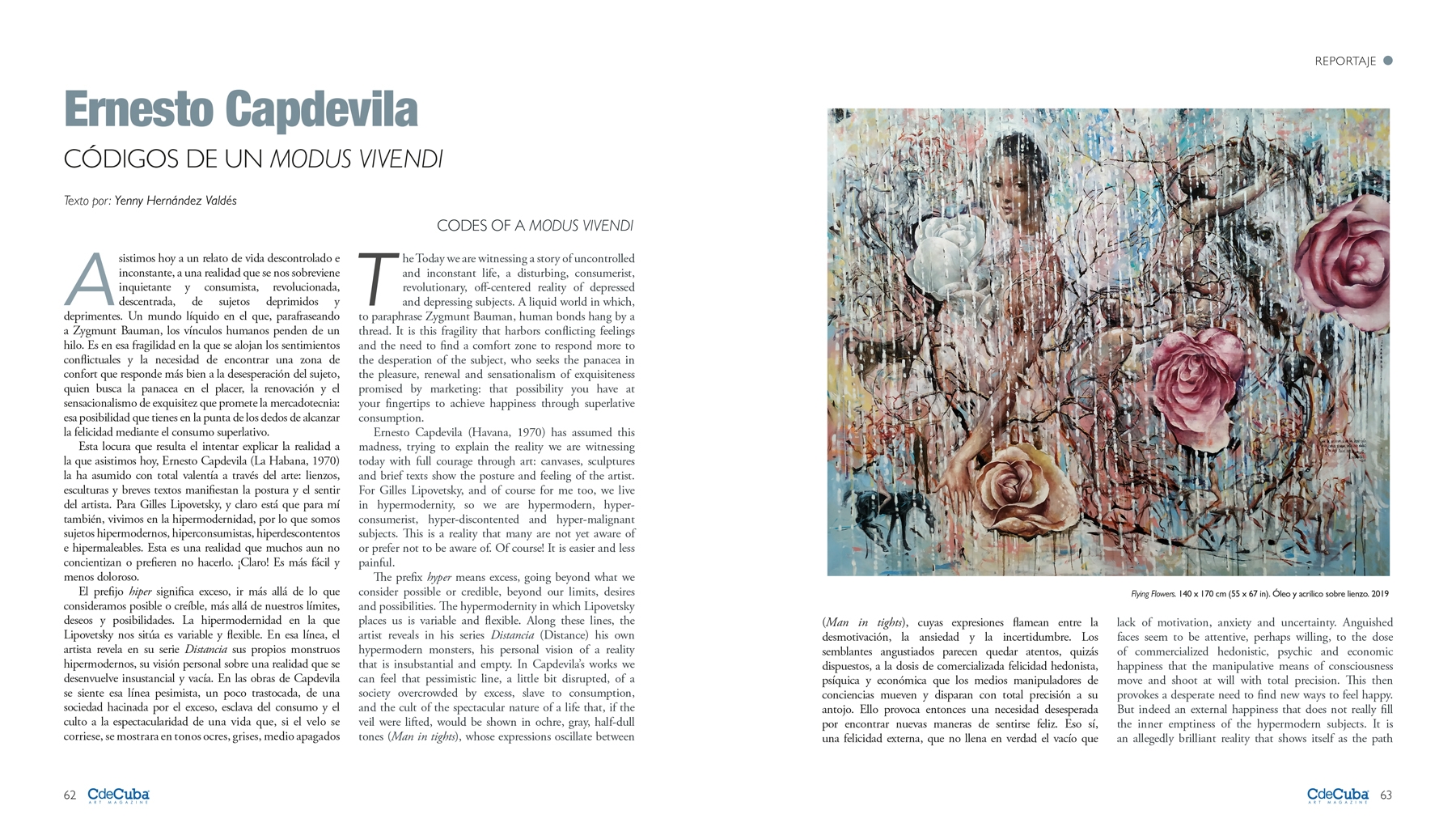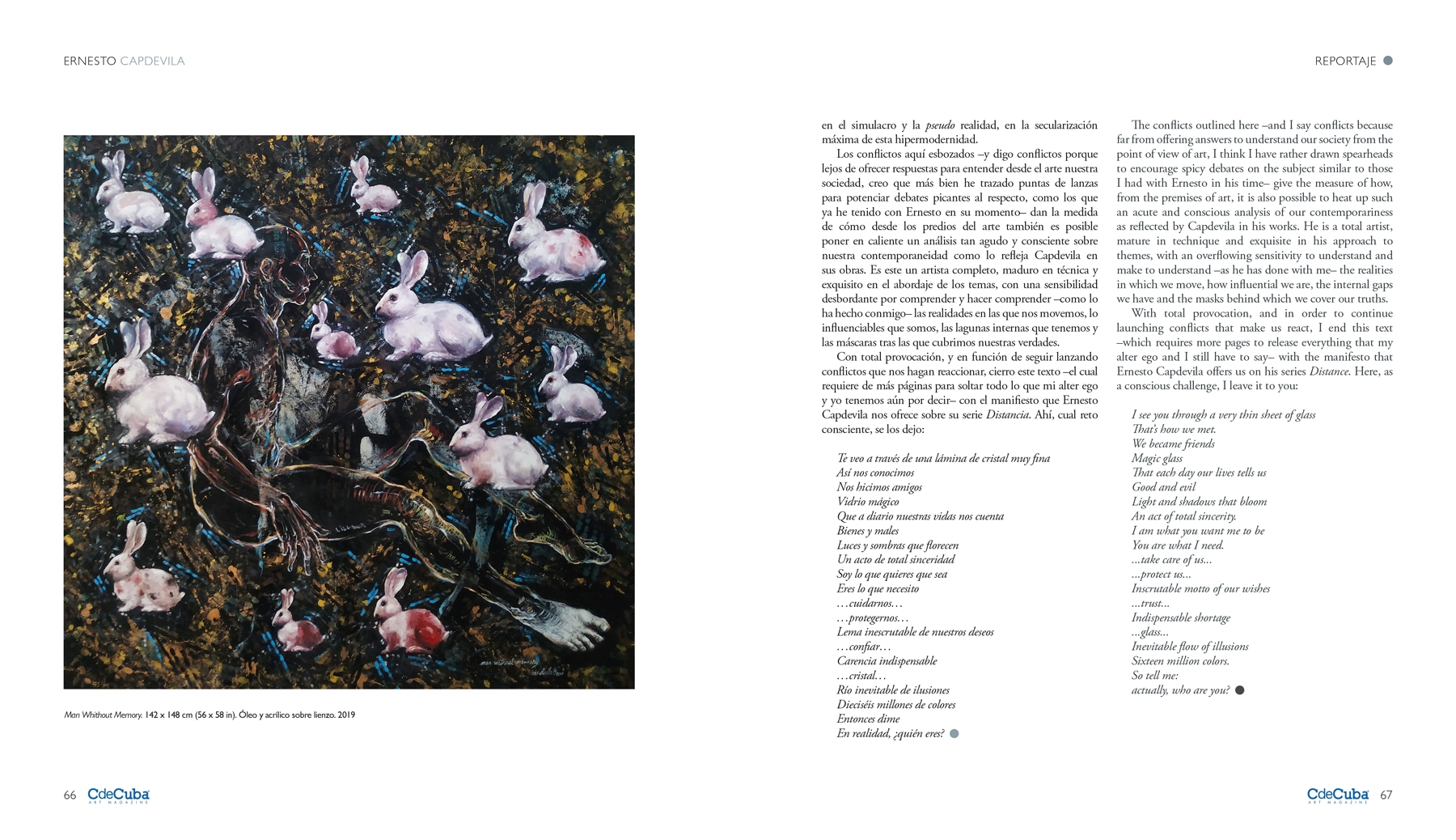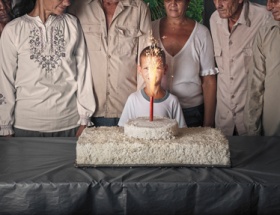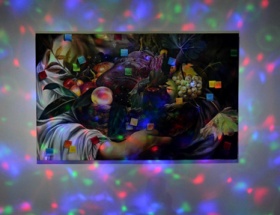Codes of a modus vivendi
By Yenny Hernández Valdés
“”Our world has given birth to desires for happiness impossible to satisfy,
hence the proliferation of disappointments concerning a life that never
is light enough and fun enough and mobile enough… A new spirit of heaviness
has taken over the era.”
Gilles Lipovetsk
Today we are witnessing a story of uncontrolled and inconstant life, a disturbing, consumerist, revolutionary, off-centered reality of depressed and depressing subjects. A liquid world in which, to paraphrase Zygmunt Bauman (1), human bonds hang by a thread. It is this fragility that harbors conflicting feelings and the need to find a comfort zone to respond more to the desperation of the subject, who seeks the panacea in the pleasure, renewal and sensationalism of exquisiteness promised by marketing: that possibility you have at your fingertips to achieve happiness through superlative consumption.
Ernesto Capdevila (Havana, 1970) has assumed this madness, trying to explain the reality we are witnessing today with full courage through art: canvases, sculptures and brief texts show the posture and feeling of the artist. For Gilles Lipovetsky (2), and of course for me too, we live in hypermodernity, so we are hypermodern, hyper-consumerist, hyper-discontented and hyper-malignant subjects. This is a reality that many are not yet aware of or prefer not to be aware of. Of course! It is easier and less painful.
The prefix hyper means excess, going beyond what we consider possible or credible, beyond our limits, desires and possibilities. The hypermodernity in which Lipovetsky places us is variable and flexible. Along these lines, the artist reveals in his series Distancia (Distance) his own hypermodern monsters, his personal vision of a reality that is insubstantial and empty. In Capdevila’s works we can feel that pessimistic line, a little bit disrupted, of a society overcrowded by excess, slave to consumption, and the cult of the spectacular nature of a life that, if the veil were lifted, would be shown in ochre, gray, half-dull tones (Man in tights), whose expressions oscillate between lack of motivation, anxiety and uncertainty. Anguished faces seem to be attentive, perhaps willing, to the dose of commercialized hedonistic, psychic and economic happiness that the manipulative means of consciousness move and shoot at will with total precision. This then provokes a desperate need to find new ways to feel happy. But indeed an external happiness that does not really fill the inner emptiness of the hypermodern subjects. It is an allegedly brilliant reality that shows itself as the path of shining ways and answers that connects illusion with delirium and, I believe, with nothingness, in the end.
The development of today’s subject has evidenced itself, in the first place, in the external aspect of human reality, which in turn has caused an internal disruption, a contamination of thoughts and sensations. Together with the externalization that we want to project, it has become a symptomatic and unmistakable phenomenon of human behavior, in which miseries appear and the need for frivolous consumption and the precariousness of interpersonal ties dominate our life story to the point of being completely absorbed. Equilibrium (or imbalance) reflects this liquid world to which Bauman referred, this instability which we have already joined become a part of, and which we explore in our own daily lives according to our inner cries. Adapting to and accepting our future seems to be the way, if not the only one then the most adequate, to continue walking ahead. It is there where I allow myself to place Man without memory, a subject suspended in a sort of unstable limbo, where oscillating and discontinuous lines provoke in those who observe a sensation of frenzy, lack of control, a surreal feeling… Here we are shown the recreation of a pseudo reality of that subject that levitates, almost imperceptible among his alienations. That “man” represented by Capdevila is not just any subject; he is an alter ego that results from this hypermodern society, which I feel can also be the artist’s own alter ego that comes to life and makes sense through his works.
Ernesto creates his pieces in such a way that the surreal is mixed with the reality of his thoughts, such as the sinuous flowers (Flying Flowers), which perhaps allude to a pubis in full ecstasy, seen behind the scenes, which, like nervous lines, have arranged a stage design motif that opens up to make us participate in the fact that the artificial can become more real than reality itself.
The technological proliferation, the virtual nature of human relations, the narcissistic ideologies of false therapeutic nuances, the cult of consumption, the pretension of happiness in detriment of truth, and the external and superficial “I”, are just some of the signs of our way of life. This only tells us that there is no turning back; that we must learn to survive in this media and tasteless jungle, in the simulacrum and the pseudo reality, in the maximum secularization of this hypermodernity.
The conflicts outlined here -and I say conflicts because far from offering answers to understand our society from the point of view of art, I think I have rather drawn spearheads to encourage spicy debates on the subject similar to those I had with Ernesto in his time- give the measure of how, from the premises of art, it is also possible to heat up such an acute and conscious analysis of our contemporariness as reflected by Capdevila in his works. He is a total artist, mature in technique and exquisite in his approach to themes, with an overflowing sensitivity to understand and make to understand -as he has done with me- the realities in which we move, how influential we are, the internal gaps we have and the masks behind which we cover our truths.
With total provocation, and in order to continue launching conflicts that make us react, I end this text -which requires more pages to release everything that my alter ego and I still have to say- with the manifesto that Ernesto Capdevila offers us on his series Distance. Here, as a conscious challenge, I leave it to you:
I see you through a very thin sheet of glass
That’s how we met.
We became friends
Magic glass
That each day our lives tells us
Good and evil
Light and shadows that bloom
An act of total sincerity.
I am what you want me to be
You are what I need.
…take care of us…
…protect us…
Inscrutable motto of our wishes
…trust…
Indispensable shortage
…glass…
Inevitable flow of illusions
Sixteen million colors.
So tell me:
actually, who are you?
1. Bauman, Zygmunt (2006). Liquid Love. On the Fragility of Human Bonds. Fondo de Cultura Económica: Buenos Aires.
2. Lipovetsky, Gilles (2006). The Hypermodern Times. Anagram: Barcelona.






